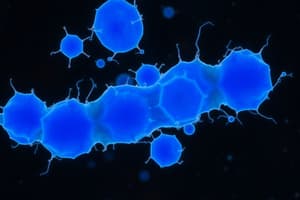Podcast
Questions and Answers
What is the primary purpose of acid-fast staining?
What is the primary purpose of acid-fast staining?
- To differentiate between Gram-positive and Gram-negative bacteria
- To identify non-acid-fast microorganisms
- To stain and identify acid-fast microorganisms (correct)
- To visualize bacterial motility
Which of the following reagents is NOT used in acid-fast staining?
Which of the following reagents is NOT used in acid-fast staining?
- Acid alcohol
- Methylene blue
- Carbolfuchsin
- Crystal violet (correct)
What color will acid-fast bacilli appear after the staining procedure?
What color will acid-fast bacilli appear after the staining procedure?
- Blue
- Green
- Yellow
- Bright red (correct)
During the decolorization process, what color should the slide remain after acid-alcohol application?
During the decolorization process, what color should the slide remain after acid-alcohol application?
What step follows the addition of acid-alcohol in the acid-fast staining procedure?
What step follows the addition of acid-alcohol in the acid-fast staining procedure?
Why is it necessary to heat the slide during the staining process?
Why is it necessary to heat the slide during the staining process?
What method is recommended to avoid boiling when heating the slide?
What method is recommended to avoid boiling when heating the slide?
How long should the alkaline methylene blue counterstain be applied?
How long should the alkaline methylene blue counterstain be applied?
What is the purpose of using a piece of paper toweling during the staining process?
What is the purpose of using a piece of paper toweling during the staining process?
At what stage of the acid-fast staining process is the slide rinsed with water for the first time?
At what stage of the acid-fast staining process is the slide rinsed with water for the first time?
Flashcards
Acid-Fast Staining
Acid-Fast Staining
A special bacteriological stain used to identify certain types of bacteria, particularly Mycobacteria species.
Acid-Fast Bacilli
Acid-Fast Bacilli
A type of bacteria that are difficult to stain with standard methods due to a waxy outer layer. They are positive in acid-fast staining.
Ziehl's Carbolfuschin
Ziehl's Carbolfuschin
A dye solution used in acid-fast staining. It stains the acid-fast bacteria red.
Acid-Alcohol
Acid-Alcohol
Signup and view all the flashcards
Methylene Blue
Methylene Blue
Signup and view all the flashcards
Heat-Fixing
Heat-Fixing
Signup and view all the flashcards
Rinse with Water
Rinse with Water
Signup and view all the flashcards
Examine under Oil Immersion
Examine under Oil Immersion
Signup and view all the flashcards
Red
Red
Signup and view all the flashcards
Blue or Brown
Blue or Brown
Signup and view all the flashcards
Study Notes
Acid-Fast Staining
- Acid-fast staining differentiates acid-fast microorganisms (e.g., Mycobacteria) and some other bacteria (e.g., Nocardai)
- Also known as Ziehl-Neelsen staining
- Uses carbolfuchsin, acid-alcohol, and methylene blue as reagents
- Acid-fast bacilli appear bright red after staining
Procedure
- Smear Preparation: Prepare a smear of the microorganisms and heat-fix it
- Carbolfuchsin Application: Cover the smear with Ziehl's carbolfuchsin, heat for 3-5 minutes (avoid drying or boiling). A staining rack or loop held above boiling water works
- Washing: Rinse with water for 30 seconds
- Decolorization: Carefully add acid-alcohol dropwise until the slide is slightly pink (10-30 seconds)
- More Washing: Rinse with water for 5 seconds
- Counterstaining: Stain with alkaline methylene blue for 2 minutes
- Final Rinse: Rinse with water for 30 seconds
- Drying & Observation: Blot dry and examine under oil immersion
- Results: Acid-fast organisms stain red; other organisms stain blue or brown
Studying That Suits You
Use AI to generate personalized quizzes and flashcards to suit your learning preferences.




